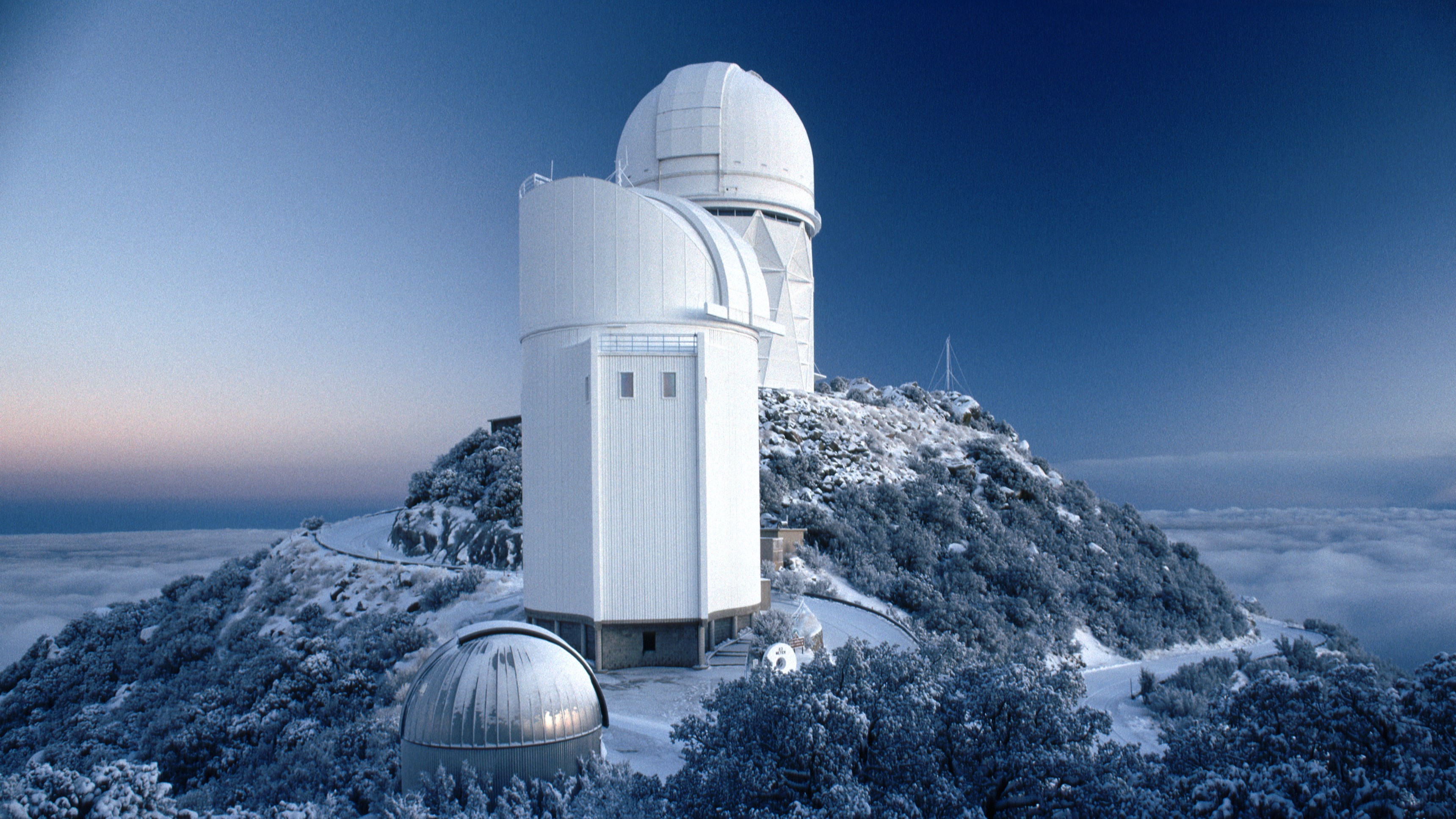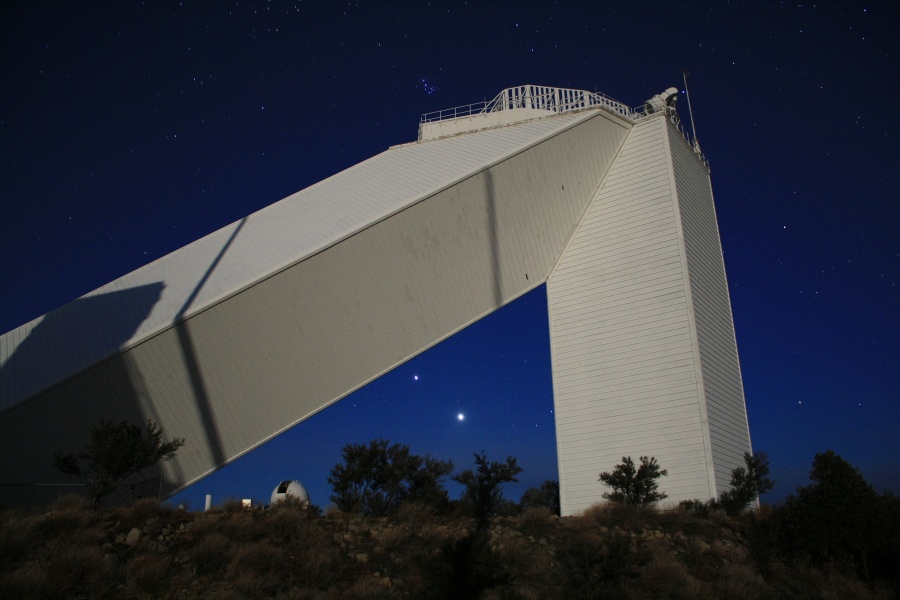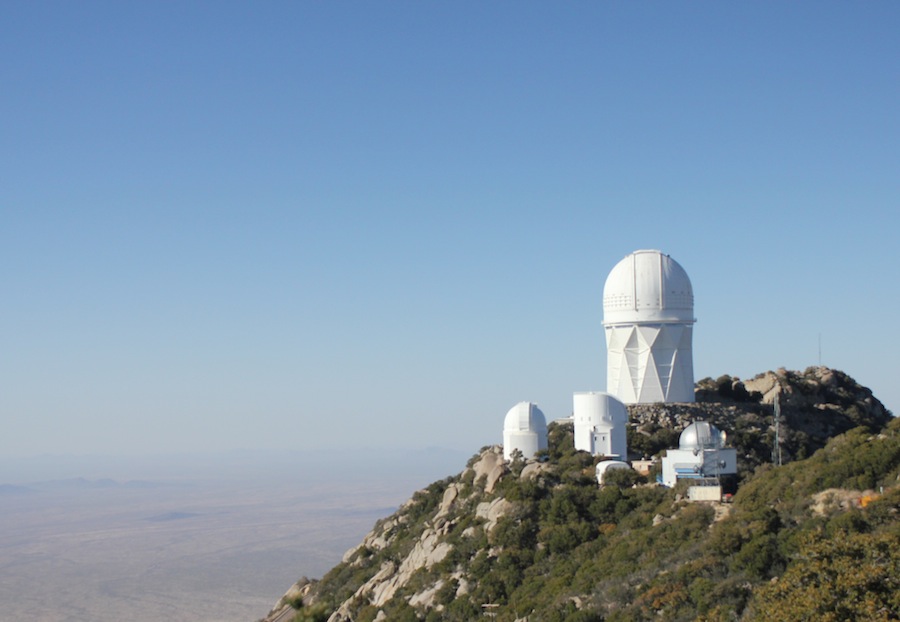Kitt Peak National Observatory: Facts, research and visitor information
Everything you need to know about the Kitt Peak National Observatory.

Kitt Peak National Observatory (KPNO) is a U.S. astronomical observatory on Kitt Peak in Pima County, Arizona. It was the first national optical observatory in the U.S. Located about 54 miles (87 kilometers) from Tucson, the observatory is in the Schuk Toak District on the Tohono O'odham Nation, according to the observatory's website.
The observatory hosts two dozen optical and radio telescopes, making it home to one of the largest and most diverse collections of telescopes in the world. Visitors have access to four of these telescopes during the observatory's well-known stargazing programs.
KPNO was founded in 1958, while the visitor center has existed since 1964 and has been visited by over 2 million people. It is a program of NOIRLab, the National Optical-Infrared Astronomy Research Laboratory, which is sponsored by the National Science Foundation.
Kitt Peak National Observatory FAQs
Is Kitt Peak National Observatory open to the public?
Yes, it is open to the public via the visitor center, nighttime stargazing programs and daytime tours. Four telescopes are available for use during these programs at the visitor center. You can learn more about these programs on Kitt Peak's website.
How many telescopes does Kitt Peak have?
The observatory directly operates two research telescopes. It also hosts 22 optical telescopes and two radio telescopes, which are operated by many universities and institutions.
Why is Kitt Peak famous?
Kitt Peak has one of the largest collections of optical and radio telescopes in the world. It was the first national astronomical observatory in the U.S. and is well known for its extensive outreach programs. Also, Kitt Peak hosted the first telescope, which was operated by the University of Arizona's Spacewatch program; it was used with a software program to automatically discover a near-Earth asteroid; and data from its Mayall Telescope led to the discovery of methane ice on Pluto.
History of Kitt Peak National Observatory
Kitt Peak is the highest point in Arizona's Quinlan Mountains. The Indigenous people of the Tohono O'odham Nation call it Iolkam Du'ag, meaning "mountain of Manzanita shrubs," according to ICT. In English, Kitt Peak was named for Philippa (Roskruge) Kitt, the sister of 19th-century surveyor George Roskruge.
During the Cold War, many astronomers petitioned the government to establish a large national observatory. Astronomers in the eastern U.S. were particularly interested, because rain and snow often made it difficult for them to make astronomical observations. Astronomers began searching for a location for this new observatory in 1955.
Several sites were considered because of their dark skies, but astronomers concluded that Kitt Peak was the best choice, in part because of its relative closeness to Tucson and its international airport. In 1956, astronomers Helmut Abt and Aden Meinel got permission to ride up the mountain on horseback with two O'odham guides, who explained the cultural significance of the mountain to the tribe. In 1958, the tribe agreed to lease the peak to the National Science Foundation.
Telescopes and research
There are two dozen telescopes at KPNO, including two that are operated by the observatory: the Nicholas U. Mayall 4-meter Telescope and the WIYN 3.5m Observatory. KPNO also hosts 22 optical telescopes and two radio telescopes that are operated by universities and research centers, including the University of Arizona, Dartmouth College, Columbia University, Case Western Reserve University, and the Southeastern Association for Research in Astronomy, according to NOIRLab.
Breaking space news, the latest updates on rocket launches, skywatching events and more!
Data collected by Kitt Peak's many telescopes is used in a wide variety of research projects. One of the best-known current projects is the Dark Energy Spectroscopic Instrument (DESI), which is using the observatory's Mayall Telescope to create a detailed map of the universe, in hopes of unraveling how the mysterious force of dark energy is accelerating the expansion of our universe. Another project, the NN-explore Exoplanet Investigations with Doppler spectroscopy (NEID), uses the WIYN Observatory to measure the precise movement of nearby stars to identify potential exoplanets.
KPNO telescopes have been used to make some well-known discoveries. The first telescope to use software to identify a near-Earth asteroid was on Kitt Peak, as a part of the University of Arizona's Spacewatch program. Spacewatch's state-of-the-art equipment on Kitt Peak continues to make it the world's most productive station for observing asteroids, comets and similar objects. Kitt Peak's Mayall Telescope was also used to discover methane ice on Pluto in 1976.
Visiting Kitt Peak
Contrary to the climate in much of the Sonoran Desert, the high elevation of the observatory means that it is usually 15 to 20 degrees Fahrenheit (8 to 11 degrees Celsius) cooler at the observatory than in Tucson, according to the observatory's website, which recommends dressing warmly between late fall and mid-spring, including wearing a hat, gloves and an insulated jacket, and even bringing blankets, especially for night programs.
During the day, the observatory offers tours of the telescopes owned by the facility, including the Mayall Telescope and the KPNO 2.1-meter Telescope, which are currently operational, and the McMath-Pierce Solar Telescope, which was decommissioned in 2017. The observatory is currently transforming the retired telescope into a center for public astronomy programming called the Windows on the Universe Center for Astronomy Outreach.
KPNO also offers nighttime programs, which use the four telescopes at the visitor's center. Its Nightly Observing Program offers visitors a guided astronomy experience — first observing stars and constellations with high-powered binoculars and then using one of the telescope domes for a more detailed view. The program lasts four to five hours.
For a full astronomer-in-residence experience, the observatory also offers the Overnight Telescope Observing Program, a custom overnight program for groups of up to four people. The program includes overnight access to one of the visitor center's telescopes, a designated telescope operator, a dorm room to stay in when you aren't observing, and three meals. You can make your own list of observing targets or have the operator create one for you. No previous experience in astronomy is required.
Expert Q&A

David Schlegel is an astrophysicist at Lawrence Berkeley National Laboratory and a project scientist for the Dark Energy Spectroscopic Instrument. His research has focused on studying and mapping the structure of galaxies and the universe. These maps enable researchers to study dark matter, the undetectable matter that makes up most of the matter in the universe, and dark energy, the enigmatic force causing the expansion of our universe to accelerate.
What is the Dark Energy Spectroscopic Instrument?
The Dark Energy Spectroscopic Instrument (DESI) is the most ambitious multiobject spectrograph ever built. The Mayall Telescope was rebuilt with a set of 6-meter-scale [20 feet] lenses that allows observing a field of view that's 40 times larger than the full moon. Within that field, a set of 5,000 robots reposition optical fibers every 15 minutes. Those fibers capture light from up to 5,000 stars, galaxies and quasars, splitting the light from each object into 12,000 wavelength channels in a set of 30 spectroscopic cameras. This gives DESI a map-making speed more than 10 times faster than any other telescope.
How will the DESI survey hopefully change or enrich our understanding of the universe?
DESI is making the largest three-dimensional maps of the universe by measuring the velocities and inferred distances to 40 million galaxies and quasars. These objects extend to distances of 11 billion light-years, which is most of the way across the 13.7 billion light-years of the observable universe.
Dark energy is a force that has profoundly impacted the history of the universe by accelerating its expansion over the past 6 billion years. Dark energy has effectively created more space in the local universe, which is evident in the greater-than-expected distances between galaxies and a corresponding reduction in the gravitational attraction between those galaxies. DESI will measure these effects from dark energy, thus informing this least-understood of the fundamental forces.
What were some of the most notable results from DESI's early data release?
The DESI early data release contains spectra and redshifts for 2 million stars, galaxies and quasars. This represents only a small fraction of the 40 million galaxies and quasars that will be mapped by 2026 but demonstrates the quality of the data. This early release includes discoveries of 400 new quasars from when the universe was less than 1.2 billion years old, which are being used to study the properties of early supermassive black holes at the cores of those quasars.
What makes Kitt Peak and the Mayall 4-meter Telescope a good location and telescope for DESI?
Kitt Peak is a premier site for professional astronomy, purportedly with the largest collection of such telescopes in the world. The Mayall Telescope is a superb platform for DESI for two reasons. The first is that it has a large light-collecting area with a 3.8-meter-diameter [12.5 feet] primary mirror of a Ritchey-Chretien optical figure that allows it to be corrected to a large field of view. The second is that the telescope is massive enough, with a moving weight of 375 tons, that it can support the 6 tons of optical corrector and steel work on its top end. The Mayall Telescope is one of only a handful of telescopes in the world that could satisfy these technical requirements.
Additional resources
To find more news and current updates from KPNO, you can follow its social media pages, including on X (formerly Twitter) and Facebook. You can book a spot for daytime tours and nighttime programs on Eventbrite. You can learn more about the Windows on the Universe Center for Astronomy Outreach on AURA's website.
Bibliography
NSF, NOIRLab, and AURA. “About KPNO.” https://kpno.noirlab.edu/about/
NSF, NOIRLab, and AURA. “Daytime Tours.” https://kpno.noirlab.edu/tours-programs/daytime-tours/
NSF, NOIRLab, and AURA. “Nighttime Programs.” https://kpno.noirlab.edu/tours-programs/nighttime-programs/
NOIRLab. “Kitt Peak National Observatory.” https://noirlab.edu/public/programs/kitt-peak-national-observatory/
NOIRLab, “Mid-Scale Observatories — Kitt Peak National Observatory.” https://noirlab.edu/science/programs/kpno
NOIRLab. “NEID.” https://noirlab.edu/public/projects/neid/
Penn State University. “What is NEID?” https://neid.psu.edu/
AURA. “Kitt Peak National Observatory.” https://www.aura-astronomy.org/centers/nsfs-oir-lab/kitt-peak-national-observatory/
Ramon-Sauberan, Jacelle. “Kitt Peak National Observatory and Native Americans Go Way Back,” ICT News, October 11, 2018, updated September 13, 2018. https://ictnews.org/archive/kitt-peak-national-observatory-and-native-americans-go-way-back
Dark Energy Spectroscopic Instrument and Lawrence Berkeley National Laboratory. “Science,” 2018. https://www.desi.lbl.gov/
The University of Arizona. “SPACEWATCH,” 2024. https://spacewatch.lpl.arizona.edu/
Sullivan, Walter. “Frozen Methane Sighted on Pluto,” The New York Times, April 2, 1976. https://www.nytimes.com/1976/04/02/archives/frozen-methane-sighed-on-pluto-planet-may-be-smaller-than-thought.html

Rebecca Sohn is a freelance science writer. She writes about a variety of science, health and environmental topics, and is particularly interested in how science impacts people's lives. She has been an intern at CalMatters and STAT, as well as a science fellow at Mashable. Rebecca, a native of the Boston area, studied English literature and minored in music at Skidmore College in Upstate New York and later studied science journalism at New York University.


